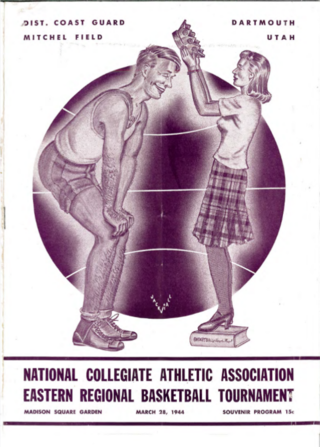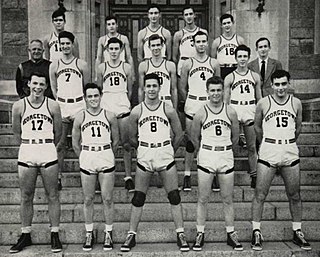Related Research Articles

The National Invitation Tournament (NIT) is a men's college basketball tournament operated by the National Collegiate Athletic Association (NCAA). The tournament is played at regional sites with its Final Four traditionally played at Madison Square Garden (MSG) in New York City each March and April. It was founded in 1938. The NIT was once considered the most prestigious post-season showcase for college basketball.

The 1982 NCAA Division I men's basketball tournament involved 48 schools playing in single-elimination play to determine the national champion of men's NCAA Division I college basketball. It began on March 11, 1982, and ended with the championship game on March 29 in the Louisiana Superdome in New Orleans, Louisiana. A total of 47 games were played.
The 1946 NCAA basketball tournament involved 8 schools playing in single-elimination play to determine the national champion of men's NCAA Division I college basketball. It began on March 21, 1946, and ended with the championship game on March 26 in New York City. A total of 10 games were played, including a third-place game in each region and a national third-place game.
The 1941 NCAA basketball tournament involved eight schools playing in single-elimination play to determine the national champion of men's NCAA college basketball. It began on March 21, 1941, and ended with the championship game on March 29 in Kansas City, Missouri. A total of nine games were played, including a third place game in both regions.

The 1944 NCAA basketball tournament involved eight schools playing in single-elimination play to determine the national champion of men's NCAA Division I college basketball. It began on March 24, 1944, and ended with the championship game on March 28 in New York City. A total of nine games were played, including a third place game in each region.
The 1945 NCAA basketball tournament was an eight-team single-elimination tournament to determine the national champion of men's National Collegiate Athletic Association (NCAA) college basketball. It began on March 22, 1945, and ended with the championship game on March 27 in New York City. A total of nine games were played, including a third place game in each region.
The 1947 NCAA basketball tournament involved eight schools playing in single-elimination play to determine the national champion of men's NCAA Division I college basketball. It began on March 19, 1947, and ended with the championship game on March 25 in New York City. A total of 10 games were played, including a third place game in each region and a national third place game.
The 1948 NCAA basketball tournament involved 8 schools playing in single-elimination play to determine the national champion of men's NCAA Division I college basketball. It began on March 19, 1948, and ended with the championship game on March 23 in New York City. A total of 10 games were played, including a third place game in each region and a national third place game.
The 1949 NCAA basketball tournament involved eight schools playing in single-elimination play to determine the national champion of men's NCAA Division I college basketball. It began on March 18, 1949, and ended with the championship game on March 26 in Seattle, Washington. A total of 10 games were played, including a third place game in each region and a national third place game.
The 1950 NCAA basketball tournament involved 8 schools playing in single-elimination play to determine the national champion of men's NCAA college basketball. It began on March 23, 1950, and ended with the championship game on March 28 in New York City, New York. A total of 10 games were played, including a third place game in each region and a national third place game.
The 1951 NCAA basketball tournament involved 16 schools playing in single-elimination play to determine the national champion of men's NCAA Division I college basketball. It began on March 20, 1951, and ended with the championship game on March 27 at Williams Arena in Minneapolis, Minnesota. A total of 18 games were played, including a third place game in each region and a national third place game.
The 1955 NCAA basketball tournament involved 24 schools playing in single-elimination play to determine the national champion of men's NCAA Division I college basketball. It began on March 8, 1955, and ended with the championship game on March 19 in Kansas City, Missouri. A total of 28 games were played, including a third-place game in each region and a national third-place game.

The Georgetown Hoyas men's basketball program represents Georgetown University in NCAA Division I men's intercollegiate basketball and the Big East Conference. Georgetown has competed in men's college basketball since 1907. The current head coach of the program is Ed Cooley.

The Wyoming Cowboys and Cowgirls are the athletic teams that represent the University of Wyoming, located in Laramie. Wyoming is a member of the Mountain West Conference (MW) and competes in NCAA Division I, fielding 17 NCAA-sanctioned sports. Two Wyoming teams compete in other conferences in sports that the MW does not sponsor. The men's swimming and diving team competes in the Western Athletic Conference, and the wrestling team competes in the Big 12 Conference.

The St. John's Red Storm men's basketball team represents St. John's University located in Queens, New York. The team participates in the Big East Conference. As of the end of the 2021–22 season, St. John's ranked ninth with 1,904 total wins among NCAA Division I teams. St. John's has appeared in 30 NCAA tournaments, most recently appearing in 2019. The Red Storm's best finish in the NCAA tournament came in 1952 when they were NCAA runner-ups and made the Final Four. St. John's also made a Final Four appearance in 1985. St. John's is coached by Rick Pitino.

The 1981–82 Georgetown Hoyas men's basketball team represented Georgetown University in the 1981–82 NCAA Division I college basketball season. Led by tenth-year head coach John Thompson, it was the first season in which they played their home games at the Capital Centre in suburban Landover, Maryland, except for five games at McDonough Gymnasium on campus in Washington, D.C.

The 1942–43 Wyoming Cowboys basketball team represented the University of Wyoming in NCAA men's competition in the 1942–43 NCAA college basketball season. The Cowboys won the Mountain States Conference championship and were the first basketball team from the Rocky Mountains to win an NCAA title. Kenny Sailors of Hillsdale, Wyoming averaged 15.5 points per game and Milo Komenich averaged 16.7 points per game in leading the team to the championship. Despite playing just nine home games during the year, the Cowboys won 32 games.

The 1942–43 Georgetown Hoyas men's basketball team represented Georgetown University during the 1942–43 NCAA college basketball season. Elmer Ripley coached it in his seventh of ten seasons as head coach; it was also the fifth and final season of his second of three stints at the helm. The team returned to Tech Gymnasium – where Georgetown had played its home games from 1929 to 1940 – on the campus of McKinley Technical High School in Washington, D.C., for its home games. It finished with a record of 22–5 (.815) and became the first Georgetown team in history to participate in a post-season tournament, advancing to the final game of the NCAA tournament, losing to Wyoming. Its youth and inexperience led it to be nicknamed the "Kiddie Korps."
The 1945–46 NCAA men's basketball season began in December 1945, progressed through the regular season and conference tournaments, and concluded with the 1946 NCAA basketball tournament championship game on March 26, 1946, at Madison Square Garden in New York, New York. The Oklahoma A&M Aggies won their second NCAA national championship with a 43–40 victory over the North Carolina Tar Heels.
The 1942–43 NCAA men's basketball season began in December 1942, progressed through the regular season and conference tournaments, and concluded with the 1943 NCAA basketball tournament championship game on March 30, 1943, at Madison Square Garden in New York, New York. The Wyoming Cowboys won their first NCAA national championship with a 46–34 victory over the Georgetown Hoyas.
References
- 1 2 "Georgetown beaten by Wyoming, 46-34". Milwaukee Journal. United Press. March 31, 1943. p. 8, part 2.
- 1 2 "Wyoming defeats Georgetown, 46-34, for NCAA basketball title". Eugene Register-Guard. (Oregon). March 31, 1943. p. 8.
- 1 2 "Wyoming takes coveted crown". Spokane Daily Chronicle. (Washington). United Press. March 31, 1943. p. 11.
- ↑ "1943 NCAA basketball tournament". College Basketball Reference. Retrieved April 3, 2018.